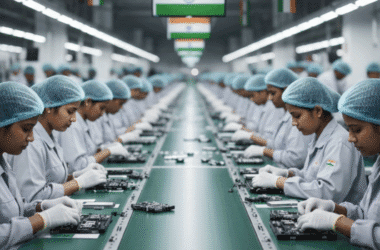The Snapdragon 8 Gen Elite SoC, Qualcomm’s latest flagship processor, has been making headlines, not just for its performance but also for its heat issues. Tech reviewer Ben Geskin recently tested the Realme GT 7 Pro, which is powered by this processor, and his experience paints a troubling picture for gamers and heavy users.

Gaming Test: The Heat is Real
Ben Geskin ran two demanding games on the Realme GT 7 Pro:
- MadOut 2
- Settings: Max Graphics.
- Performance: The game started at 45 FPS but dropped to 33 FPS within 10 minutes.
- Wreckfest
- Settings: Max Graphics, highest brightness, GT Turbo Game Settings set to Balance Mode.
- Performance: Started at 60 FPS with a temperature of 26°C. After 15 minutes, FPS dropped to 50, and the phone’s temperature soared to 43°C.
User Experience: Burning Hands and Throttling Performance
Geskin reported discomfort while holding the device:
- The hottest spot was near the chip area, with the top frame also heating up significantly, where gamers typically rest their hands.
- After 15 minutes, the phone became so hot that his hand turned red, taking 20 minutes to recover.
- The phone even started emitting a melted plastic smell, a rare and alarming occurrence in modern smartphones.
Quote: “This is the hottest phone I’ve ever held – literally.”

Opinion: Is the Snapdragon 8 Gen Elite Worth It?
- Thermal Management Issues:
- Qualcomm’s Snapdragon 8 Gen Elite may deliver raw performance, but its thermal management is a clear drawback.
- Realme’s 11,480mm² double-layer VC cooling system appears insufficient for sustained gaming, raising concerns about long-term reliability.
- Gaming Experience:
- While the chip supports high frame rates, thermal throttling quickly diminishes performance. For a flagship SoC, maintaining consistent FPS is a baseline expectation, and the Snapdragon 8 Gen Elite falls short.
- User Comfort:
- A smartphone overheating to the point of causing physical discomfort undermines its usability, especially for gamers who rely on extended sessions.
The Bigger Picture: A Trend in Flagship SoCs?
This isn’t the first time Qualcomm has faced criticism for overheating chips. Past generations like the Snapdragon 810 and Snapdragon 888 also garnered complaints about high temperatures.
- Trade-offs: As flagship chips push performance boundaries, power efficiency and heat management often suffer.
- Competition: Rivals like Apple’s A-series chips and MediaTek’s Dimensity series have demonstrated better thermal efficiency in some cases, putting Qualcomm at risk of losing its edge.
How Can Qualcomm and OEMs Fix This?
- Optimized Cooling Solutions:
- Smartphone manufacturers need to invest in more innovative cooling technologies, such as graphene heat dissipation sheets or active cooling systems.
- Software Tweaks:
- A more aggressive thermal management algorithm could help control temperatures better, even at the cost of slightly lower performance.
- User Awareness:
- Transparent communication about device performance under heavy loads can manage user expectations and minimize backlash.
Alternatives for Gamers
Gamers looking for a consistent experience without overheating should consider alternatives:
- MediaTek Dimensity 9300: Known for power efficiency and better thermal management.
- Apple A17 Pro: Delivers high performance with minimal heating, though exclusive to iPhones.
Conclusion
The Snapdragon 8 Gen Elite showcases Qualcomm’s ability to push performance limits, but it comes at the cost of usability and comfort. For gamers and heavy users, the Realme GT 7 Pro’s heating issues highlight a critical flaw in current flagship processors.
While Qualcomm and OEMs may address these problems in future iterations, users should weigh the performance vs. comfort trade-off before committing to a device with the Snapdragon 8 Gen Elite.









